Eric Zweig's Blog, page 24
November 4, 2015
Building a Better Puck
Back in March, I wrote about Frank Patrick trying to come up with a glowing puck for better visibility … back in 1941. The other day, I came across this, which appeared in Sports Editor Frederick Wilson’s column in Toronto’s Globe newspaper on February 17, 1927:
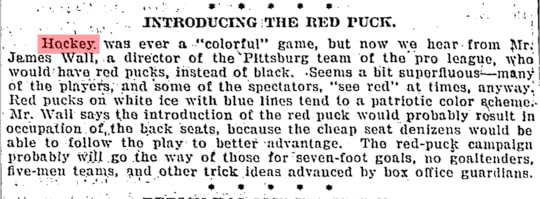
Interesting that Wilson lumps this in with “other trick ideas” such as seven-foot nets and five-man teams, which I also wrote about back in March. I’m not going to go into to bigger nets again, but just consider this…
Space available around 5’3” Roy Worters, the smallest goalie in NHL history:

Space available around 6’7” Ben Bishop, the tallest goalie in NHL history:
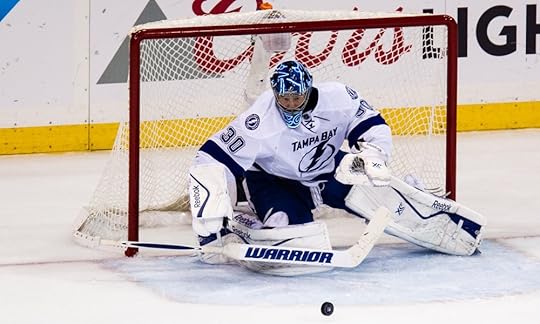
Regardless of who’s in the Hockey Hall of Fame, which one looks easier to score on?!?
But let’s get back to pucks for a moment. Art Ross III shared this story with me during the writing of Art Ross: The Hockey Legend Who Built the Bruins. Among his many contributions to the game, Art Ross is famous for designing (refining, really) the modern hockey puck. But his son, the second Art Ross and father of Art III, figured he had a way to make it even better. This would likely be some time during the late 1950s. It didn’t work out.
Dad got the idea for a new puck, one with more color and, therefore, “followability.” Spaced at equal intervals around the outer inter edge of the black puck were orange inserts. The color matched the label on the puck. I seem to recall that the first trial version had triangular wedges – think pie slices – but the final product had something on the order of a hollowed out cylinder: a round disk on the top and bottom, same beveled edges, but the disks would be connected by a thin strip of black rubber which was counter-sunk into the edge rubber. It’s a bit hard to describe, but the point was that there were six orange implants on the outer edge of the puck giving it enhanced visibility and a cool look if you spun it slowly. Dad, ever creative and thoughtful, decided to call his innovation an “Art Ross Puck.” You didn’t need a focus group for that one.
We lived in [the Boston suburb of] Newton at the time on the Charles River, a good part of which froze each winter. My sisters and I were the OPTs – Official Puck Testers – and Dad joined us a couple of times. It was great fun zipping around whacking the disc with vigor and, best of all, we had almost an unlimited supply of pucks! It wasn’t very long, however – like two days, maybe – before the OPTs noticed a problem. On a couple of pucks, the implants had fallen out. This looked ugly and could cut someone. Soon most of the pucks had missing inserts, and Dad was beside himself. He immediately called the manufacturer, and they had a heated discussion about rubber glue, or more accurately, glue for rubber. Two or three weeks later a couple of boxes of new pucks showed up. Not willing to wait, the OPTs whacked the pucks around the driveway. Alas, the same result: little pieces of orange puck edge all over the place.
In case you haven’t read my book yet (and if not, why not?!?), the NHL first started using Art Ross’s puck design during its second season of 1918-19. The bevelled edges reducing rolling and injuries, but the NHL didn’t always stick with it. The advent of artificial rubber during World War II improved Ross’s design. He received a U.S. patent in 1940 and the new Ross-Tyer puck was adopted as the NHL’s official puck before the 1940-41 season. Ross’s puck patent has long since expired, but the basic design has never really changed.

October 27, 2015
Promoting Art Ross
Back in February, while I will still hard at work on Art Ross: The Hockey Legend Who Built the Bruins, Art Ross III (who, along with his wife and his sisters, have all been great supporters – and great helps – on the project) sent me a few clippings from Boston Bruins programs he found in a family scrapbook. This story below appeared almost 44 years ago, on November 19, 1961, just over seven years after Art Ross had retired from the Bruins. Several bits and pieces from this article made their way into my biography … but I particularly liked where Henry McKenna noted: “So you can see that trying to write about Art Ross in a single chapter is virtually impossible. A book perhaps, but hardly a single article.”
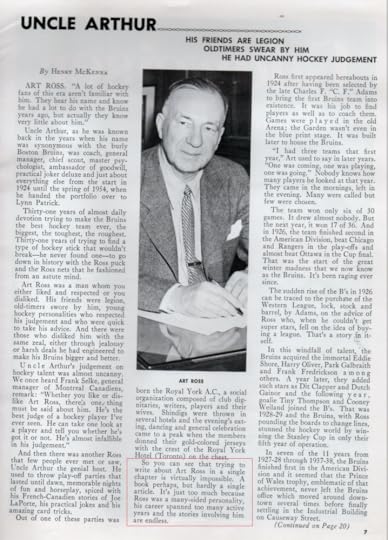
So, why has it taken so long for somebody to write this book? I offer a few thoughts on that, as well as why I wanted to be the one to write it, on the web site of my publisher, Dundurn. Rather than write it all again, you can have a if you’re interested.
As many of you know, I’ve been out and about lately promoting the book. We had a launch in Toronto last month, and another a few days ago in Owen Sound (where the local Sun Times was the first to review the book). Barbara and I were also in Maine a couple of weeks ago for a wonderful Ross family long weekend, and then we visited Boston, where I appeared on the pregame show of a Bruins broadcast, caught up with some of the Bruins staff who had helped me along the way, and chatted with a couple of Bruins reporters.
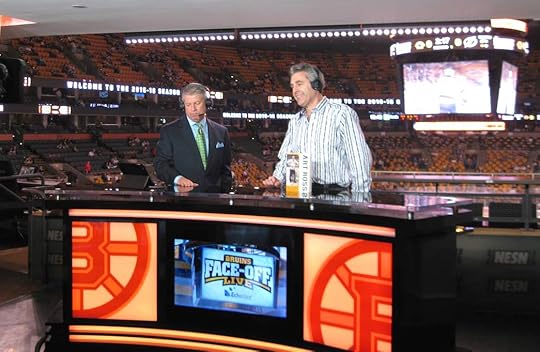
On the air with NESN’s Dale Arnold
If you’d like to see the interview I did, you have to be on Facebook, but this link should take you there. (The part with me starts 20 seconds in.) Otherwise, you can listen to the radio interview I did here in Owen Sound. In addition, there has been some great coverage from prolific American hockey writer and broadcaster Stan Fischler, and, most recently, this review from the Winnipeg Free Press. Upcoming is a radio interview with Dave Fisher on CJAD in Montreal. (Montreal friends, I’ll try to keep you posted on that one.)

At Ben McNally Books in Toronto, wearing a Montreal Wanderers sweater loaned to me by
Society for International Hockey Research president Jean-Patrice Martel. Art Ross spent most of his playing career with the Wanderers.
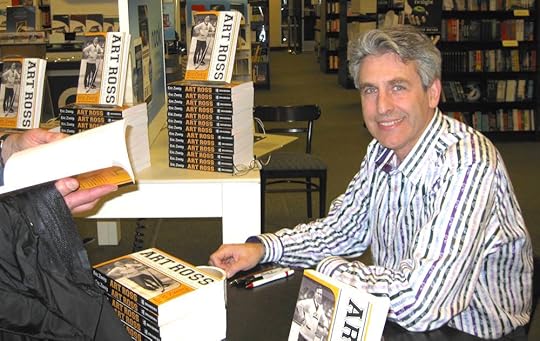
Let’s just say the Barnes and Noble at the Prudential Center in Boston
has a lot of signed copies to sell
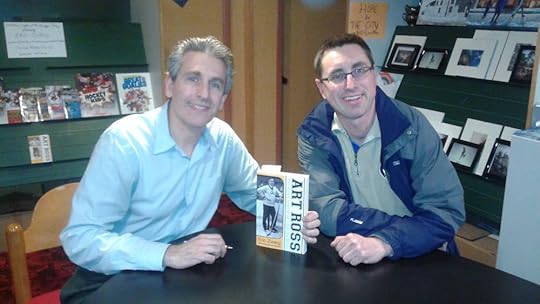
Signing for fellow SIHR member Lorne Bell at the Owen Sound launch at The Ginger Press
Oh, and by the way, if you’ve already read the book and if you liked it, feel free to offer comments and reviews on web sites such as Chapters/Indigo, Amazon, Goodreads, or Barnes and Noble. I don’t honestly know if it makes much difference, but it couldn’t hurt!
October 20, 2015
We’ve Got a Series Now…
The Blue Jays gave me an early birthday present with a big victory last night! Hoping for a similar present on my actual birthday today.
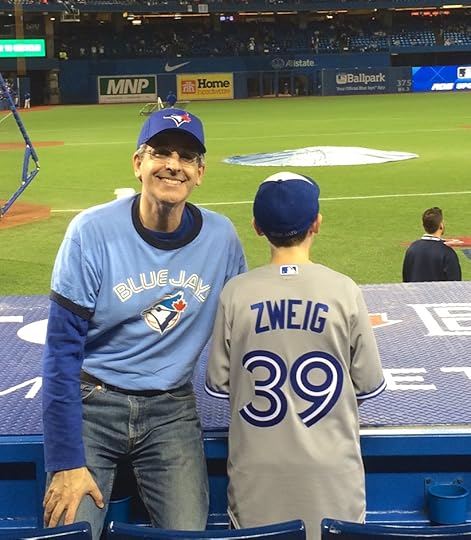
My nephew Jorey and me before the game last night.
I was more than a little worried that they’d be facing the same challenge as the 1942 Toronto Maple Leafs, who were the first team in history to rebound from a three-games-to-nothing deficit in a best-of-seven series when they rallied to beat the Detroit Red Wings for the Stanley Cup.
Toronto media seemed pleased by that victory, but few seemed to note its historic significance. Perhaps that was because the Stanley Cup Final had only expanded to a best-of-seven in 1939. Then again, the World Series had been a best-of-seven (and sometimes a best of nine!) since the beginning in 1903, and nobody had pulled of this type of comeback there … and wouldn’t until the Boston Red Sox rallied to beat the Yankees in the 2004 American League Championship series.


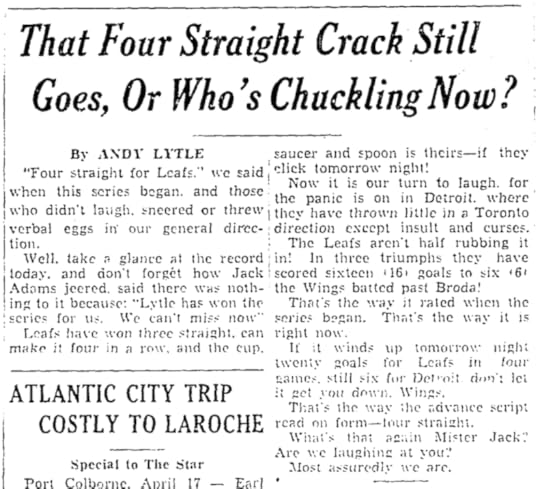
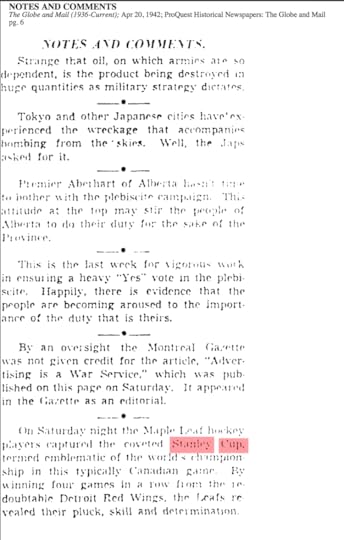
October 7, 2015
Matty and Me
My first professional writing job came 30 years ago this month when, with the Blue Jays in the playoffs for the first time, I wrote a month-long “World Series Flashback” feature for the Toronto Sun and CHEX Radio in Peterborough.
Friday of this week (October 9) until Wednesday of next week (October 14) marks the 110th anniversary of probably the greatest pitching performance in baseball history. In games one, three, and five of the 1905 World Series, Christy Mathewson pitched three straight complete game shutouts in the space of six days. He tossed a total of 27 innings, while allowing just 13 hits and striking out 18 against only a single walk. Mathewson’s New York Giants defeated the Philadelphia Athletics four games to one.
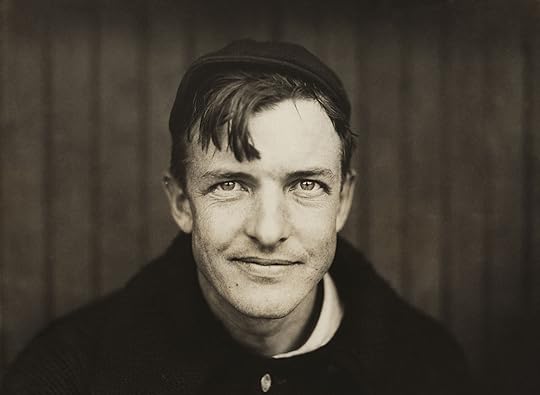
In an era when baseball players were mostly roughnecks and hooligans, Christy Mathewson was a true gentleman. College-bred, tall, handsome, honest and articulate – not to mention one of the greatest pitchers in history – Mathewson helped make baseball respectable. Had there been a World Series MVP award in 1905, there’s no doubt who would have won it. Had I been alive at the time, I don’t think there’s any doubt who my favorite baseball player would have been. (I’ve always been a fan of great pitching.)
If you’ve read any of the articles I’ve posted on this web site over the past year – or anything I’ve written over the past 30 years – you’ve got a pretty good idea that I love sports history. As a boy, I played hockey and football and loved the Toronto Maple Leafs and the Argonauts. I was a horrible baseball player, but I’d watch the Expos on TV and began following the World Series in 1972 when I was still only eight years old. I saw my first live game in 1973 and was watching on TV in 1974 when Hank Aaron passed Babe Ruth with his 715th home run. Still, I didn’t really understand baseball and didn’t care much about it. It wasn’t until the Blue Jays came along in 1977 that everything changed.
I knew that both my parents had gone to minor league Maple Leafs baseball games when they were young. My mother, especially, loved baseball, and was the reason why my family got (and still has) our Blue Jays season tickets. I was first hooked late in the summer of 1976. There was a tent that year at the Canadian National Exhibition in Toronto hyping the city’s entry into the American League. In it, they were showing the official film of the 1975 World Series. Like so many people, I’d been captivated by that series the previous fall, and this was the first time I’d ever seen one of those “all access”-style films. By the time the Blue Jays took the field on April 7, 1977, I was more than ready to fall in love with baseball. Soon, every radio in the house was tuned to the Blue Jays broadcast. (Not a lot of television in those days!)
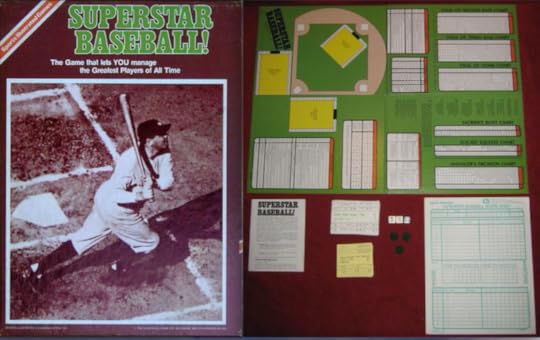
With friends who were just as crazy for the fledgling team – and the most inexpensive tickets easy to come by at just two and thee dollars (sometimes less) – it was fun to follow the Jays even if they lost 100 games every season. We also picked pennant contenders to root for and tease each other about, but what really took my interest “to the next level” was my discovery of baseball’s rich history. That began with two things in 1978.
One thing was that my mother bought us Big-Time Baseball by Maury Allen. “A potpourri of major league happenings between 1900 and 1978,” says Google Books. “Includes records, anecdotes, photographs, and biographical information.” My brothers and I devoured it! (And, really, many of the books on hockey I’ve written for children haven’t been all that different from it.)
Big-Time Baseball is where I first learned of Christy Mathewson, but where I came to really know him was as the star pitcher on my own team in Superstar Baseball … the Sports Illustrated/Avalon Hill board game my brothers and I ordered by mail and received at the Christmas holidays in December of 1978. As the box says, Superstar Baseball lets you manage the greatest players of all time (though it’s an admittedly strange mix of all-time megastars and quirky oldtimers). In addition to the number and letter codes on the front of the player cards that let you play the game, the backs of the cards contained career numbers and interesting write-ups about the players’ careers. I read them all, and then started reading all I could about baseball history.
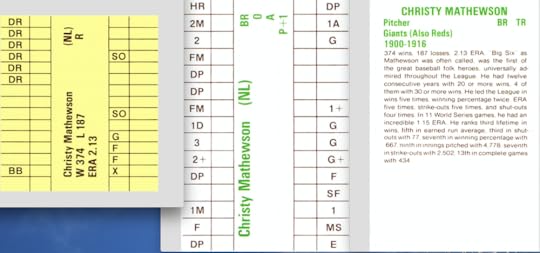
Perhaps Superstar Baseball isn’t the greatest of the dice-rolling/simulation games (I played ABPA Baseball and Football with my friends). Still, my brothers and I played it till we wore it out, ordered another, bought the second player set, and wore them out too. Almost 40 years later, we still play it when we have the time together, and are often joined now by my brother Jonathan’s son.
Over the years, we’ve traded players so many times it’s impossible to keep track of who’s had who, but David has always had Babe Ruth and Walter Johnson on his team, and Jonathan has always had Honus Wagner and Bob Gibson. My all-time all-timers are Rogers Hornsby and …Christy Mathewson.
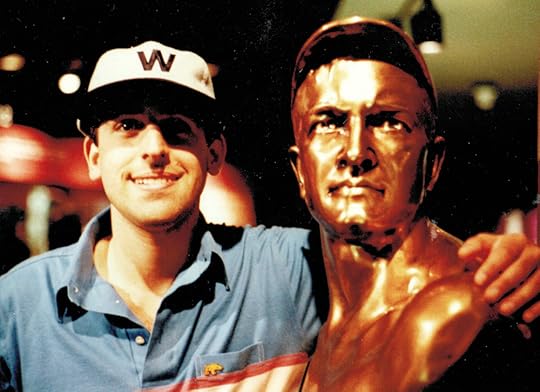
If you’ve got a story about what hooked you on sports, or sports history, I’d love to hear it. Please feel free to comment. And GO JAYS GO!
September 29, 2015
Uncle Sam Says…
Let’s face it. As Canadians, we so often like to feel ourselves superior to Americans when they get caught up in their latest national drama. But we also crave their approval when things are going well for us … such as with a certain baseball team!
In the Toronto Star last Sunday, Raju Mudhar, in his Sports Media column, brought up the issue of Bob Costas raising the ire of Toronto fans back in the 1989 playoff series against Oakland when he commented that: “Elvis has a better chance of coming back than the Jays.” Scott Moore, president of Sportnet, said, “when you get a [U.S.] network guy who is not as biased towards the Jays, people think they’re biased against them… Costas didn’t hate Toronto. He wasn’t a home-team broadcaster that our viewers are used to.”
Personally, I remember on the field during the afternoon before the 1985 Championship Series with the Royals got under way, Costas proudly speaking of how he planned to stick up for Canada. How? By mentioning that despite the cool weather in Toronto that night, there was already snow in Denver – which people at the time were touting as an obvious expansion site. Um, thanks … I guess.
I also remember how, the next day, at least one Blue Jay (it’s been 30 years, but I think it was Buck Martinez, who missed the end of the season and the playoffs that year with a broken leg,) was disappointed that Tony Kubek – who had been the analyst on Blue Jays broadcasts since nearly the very beginning – had not been supportive enough of the team in game one in his main job on the NBC broadcast. So it’s not just the fans.
Generally speaking, the U.S. media has gotten behind this year’s Blue Jays. It’s hard not to rally around a team that’s on such a roll. Still, there was that whole “Beer League” business back in August. Anyway, here’s the American view of past Blue Jays division championships in newspaper stories the following day. And here’s hoping there’s another one to add as soon as tomorrow!
Clinching Date: October 5, 1985. Blue Jays 5, Yankees 1

Clinching Date: Septmber 30, 1989. Blue Jays 4, Orioles 3

Clinching Date: October 2, 1991. Blue Jays 6, Angels 5

Clinching Date: October 3, 1992. Blue Jays 3, Tigers 1

Clinching Date: September 27, 1993. Blue Jays 2, Brewers 0
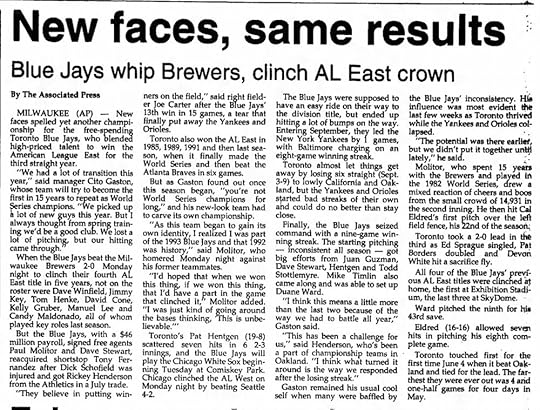
September 24, 2015
Turk Broda, Yogi Berra and the Blue Jays
Last week, when the Toronto Maple Leafs opened training camp in Nova Scotia, both new coach Mike Babcock and new GM Lou Lamoriello talked about a “clean slate,” meaning they would have no preconceived notions on players based on last year’s woeful Leafs season. It’s probably just a coincidence, but that certainly seemed apropos for the week between Rosh Hashanah and Yom Kippur.
Among the many question marks for the Leafs heading into the season is (once again) who’s going to be the number-one goalie. “I like one guy to know he’s the guy,” said Babcock. “Someone’s gotta grab it.” He’s apparently prepared to let James Reimer and Jonathan Bernier fight it out. Bernier and Reimer both have their supporters among Toronto fans … but it’s not exactly like the Leafs are battling with the embarrassment of riches they faced at training camp back in the fall of 1936.
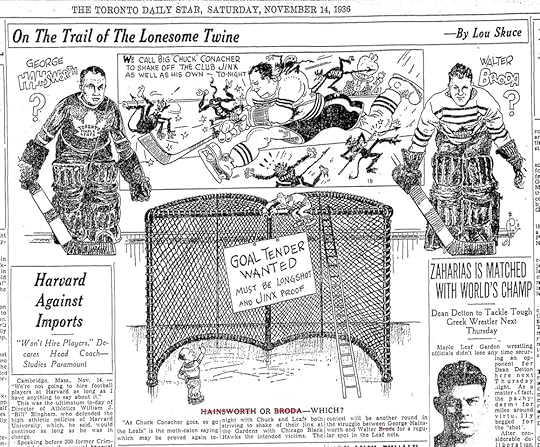
“Brilliant playing of some and more or less disappointing efforts by others have left several question marks hovering over the personnel of the Maple Leaf hockey team,” wrote Don Cowie of The Globe and Mail on November 4, 1936, as Toronto readied for the NHL season opener against Detroit the following night. “The big problem is in goal, and the question being asked on all sides; Will it be Hainsworth or Broda?”
George Hainsworth was a 41-year-old veteran who’d had his best years with the Montreal Canadiens in the late 1920s, but had certainly been solid during his three seasons in Toronto. He helped the Maple Leafs win three straight Canadian Division titles from 1933-34 to 1935-36 and make two appearances in the Stanley Cup Final. Turk Broda was a 22-year-old whom the Leafs had purchased from the Red Wings for $8,000 the previous spring – an unheard of sum for a raw rookie with no NHL experience during The Great Depression.
Conn Smythe, who had operated similarly with Lorne Chabot and Benny Grant in previous seasons despite the fact that teams of this era generally went with just one goalie, stated that the Leafs would carry both George Hainsworth and Turk Broda to begin the season and that they “would alternate until the better man was determined.”

It didn’t take long for the Leafs to make a decision. On November 25, Smythe announced that Hainsworth had been released outright. Turned out to be the right move. Hainsworth was all but done, whereas Broda would become the winningest goalie in franchise history with 302 regular-season victories, and five Stanley Cup championships.
But hey, it’s still baseball season and the Blue Jays are in a pennant race! The Yankees kept things interesting this week … just as they did back in 1985. Yogi Berra – who passed away on Tuesday at the age of 90 – briefly served as Yankees manager that season. (And all season in 1984.) Though I did see him around Exhibition Stadium during my ground crew days, I have no personal memories to share. However, please enjoy these Yogi Berra-isms from my 2006 quote book for Firefly Books, Home Plate Don’t Move. And remember a 3-1/2 game lead is great, but it isn’t over til it’s over!

September 17, 2015
Mixed Memories…
With the launch of my new book Art Ross: The Hockey Legend Who Built the Bruins this Saturday, and with the Blue Jays in the heat of a pennant race for the first time since 1993, I’m a little bit torn over what to write about this week. Hockey history? Blue Jays nostalgia? Fortunately, I have one memory that combines both nicely.
I don’t recall the exact date, but it was mid September in 1986. (Looking it up, it was either September 9, 1986 or the doubleheader on September 11 after a rainout the night before. It was definitely a wet night.) The Jays were playing the Yankees at Exhibition Stadium, and I was there with my Dad. Soon, an elderly gentleman sat down next to us. To any sports fan from Toronto at the time, he was instantly recognizable. It was King Clancy.
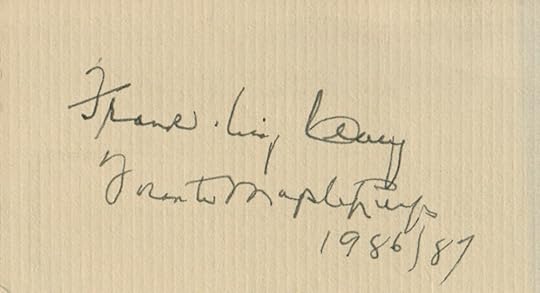
He couldn’t have been any nicer. He signed the autograph above for me that night, and really seemed to enjoy talking baseball with the people around us. Turned out, Clancy was a big fan of the Yankees’ Dave Winfield, but we were all trying to convince him that Jesse Barfield had the better arm.
On Facebook last week, after the Blue Jays swept the Yankees in New York, I posted a story about the August 2, 1983 Blue Jays doubleheader sweep of the Yankees at Exhibition Stadium. There was a record-setting crowd that night, and the joint was jumpin’! It’s one of my best memories from my Ground Crew days. As I pointed out on Facebook, the game the next night was a great one too, featuring Jesse Barfield nailing Ken Griffey at the plate on what I remember as the greatest throw I’ve ever seen.
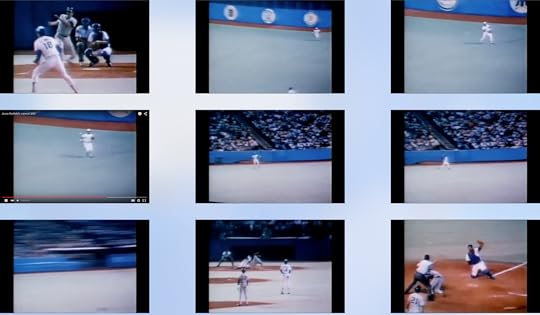
The other day, I found a YouTube clip that shows the throw. Looking at the grainy footage (the play begins at the 17-second mark), it’s a little hard to appreciate just how great that throw really was. But coming as it did in the summer of the Blue Jays’ very first pennant race, just after the Jays had gone out in front 5-1, but with the Yankees immediately threatening to get right back in the game (have a look at the Baseball-Reference summary), I’ll stick with my memory!
Oh, and by the way, it was the very next night that Dave Winfield killed that seagull. I don’t remember what King Clancy had to say about that…
September 10, 2015
A Brief History of the Hockey Phenom
So far, the NHL’s “Next One” has handled it all beautifully. Of course, the hard part hasn’t really started yet for Connor McDavid. Then again, maybe getting out there on the ice against real NHL competition, even at the age of 18, will be the easy part for McDavid. How good is he? “This guy is a special kid,” said NHL superstar Steven Stamkos the other day. “I think he’s better than me right now.”
McDavid (who trained with Stamkos for much of the summer) respectfully disagrees. “That’s obviously one of the nicest compliments,” he said, “but I don’t think that’s really true.”

“He’s definitely way ahead of where I was at 18,” Stamkos insisted. Sidney Crosby, who met McDavid briefly this summer and entered the NHL in 2005 with similar hype, says: “I think he’s got things figured out pretty early on. I understand that the expectations are high, but he looks like a guy who is going to be able to deliver on them.”
What follows is an admittedly hit-and-miss history of hockey phenoms in headlines…
Tyrone Daily Herald (Tyrone, PA). March 25, 2005.

The Kokomo Tribune (Kokomo, IN). December 15, 1994.

Morning Star (Wilmington, NC). July 1, 1992.
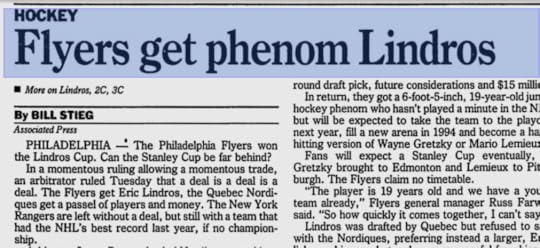
Montreal Gazette. February 3, 1984.

The Tuscaloosa News. March 26, 1982
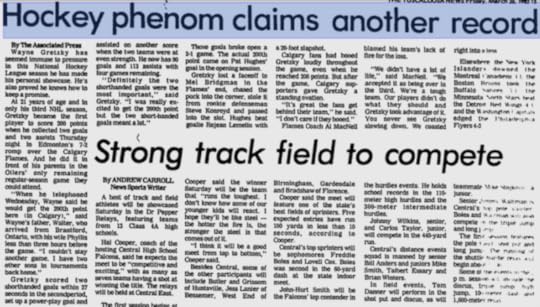
Pittsburgh Post-Gazette. July 29, 1981

The Pittsburgh Press. October 9, 1969.

Ottawa Citizen. September 14, 1957.
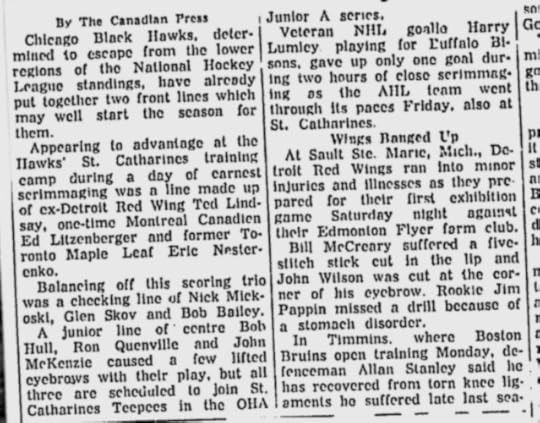
The Milwaukee Journal. February 1, 1946.

Montreal Gazette, November 9, 1942
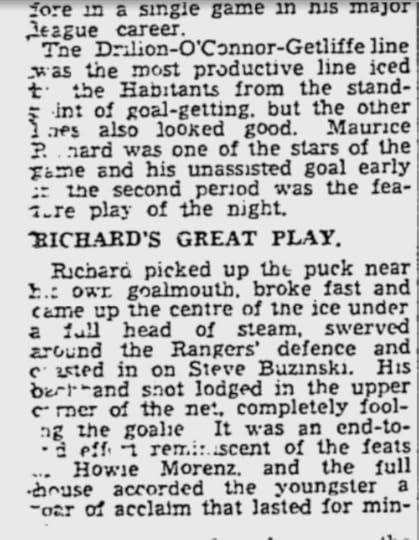
The Winnipeg Free Press. October 14, 1935.

The Ottawa Journal. March 14, 1906.
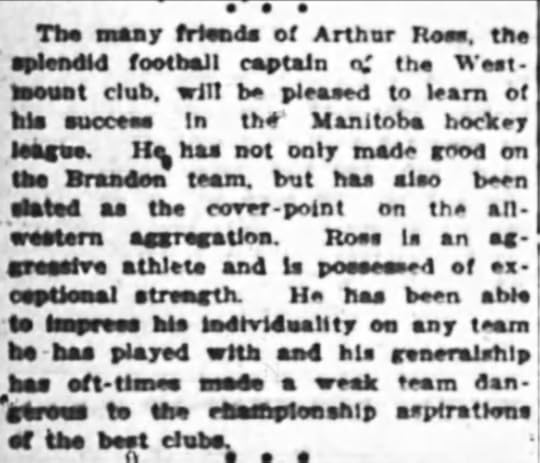
And if you haven’t already seen it, please have look at my August 20 web story about The NHL Official Guide & Record Book and Connor McDavid. The Guide will be shipped by the printer’s this week and should be in stores very soon.
September 3, 2015
A Trophy By Any Other Name
Back to hockey history this week. And, let’s be honest, a bit of book promotion too.
When I was pitching my new biography of Art Ross, I kept saying to publishing people that Ross’s name was one that every hockey fan already knew … even if they didn’t know why. That’s because, ever since the 1947-48 season, the player that leads the NHL in scoring has been rewarded with the Art Ross Trophy. As I say very early in my book, Art Ross was so much more than just a name on a trophy. But what if the NHL scoring trophy had a different name?
My experience has been that most people think the Art Ross Trophy was created by the NHL to honour Art Ross. That’s not true. None of the NHL’s early trophies were actually created by the league. Each piece of silverware was purchased independently by an individual donor who wished to turn it over to the NHL. Even the Vezina Trophy, which WAS named for Canadiens goaltender Georges Vezina, was purchased by the owners of the Canadiens and donated to the league in 1926 to honour Vezina after his career, and then his life, was cut short by tuberculosis. Previously, the Hart and Lady Byng, and later the Calder, were all originally named for the men and women who purchased those trophies and donated them to the NHL. Like those trophies, the Art Ross Trophy was actually purchased by Art Ross, along with his sons Arthur Stuart Ross and John Ross, and that’s why it bears his name to this day.

Still, it’s unclear why the NHL went more than 20 years after the donation of a trophy to recognize the league’s best goaltender before someone finally chose to honour the league’s best scorer. Charlie Conacher, a two-time NHL scoring champion (and five-time goal-scoring champion), certainly thought it was odd.
In a daily column he wrote for Toronto’s Globe and Mail newspaper during the 1936-37 season, Conacher noted on February 12, 1937: “It is the ambition of every forward to make his goals and assists reach a larger total than that of any of his rivals. I know I was always under the impression that there was a trophy for realizing this ambition until I finally was successful. Then, the year I led the league I found that with the honour went no prize that I could keep for later years.” In his column a day later – while admitting that the NHL’s maximum salary of $7,000 was a lot of money (!!!) – Conacher added that, in addition to a trophy, a cash bonus for winning the scoring title would be nice too.
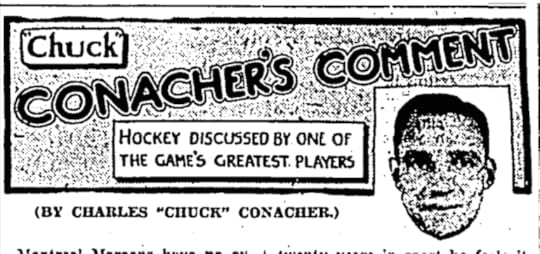
Over the next few weeks, Conacher responded to many letters he received commenting on his trophy and bonus suggestion. Most fans were against it. Some felt it would encourage selfish play (to which Conacher replied that assists were worth as many points as goals). Others felt players deserved no extra award or incentive for doing what they were already paid to do (but “winners of the Vezina, Hart and Lady Byng Trophies are only doing their duty too,” countered Conacher in his February 18 column). There were those who supported Conacher’s idea, but felt that such a trophy should be awarded to the top-scoring line, or the top-scoring team, instead of an individual player.
Nearly a month later, in his March 16, column, Conacher printed the contents of a letter he received from a Toronto man named Bob Mitchell: “I have read a great deal about your thoughts toward having a trophy for the leading scorer of the NHL…. Wouldn’t it be a fitting tribute to the late Howie Morenz if the NHL Governors donated a trophy called the Morenz Cup to be presented to the leading scorer of the NHL each season.”
Morenz had passed away on March 8, 1937, several weeks after suffering a career-ending broken leg in a game on January 28. Conacher had been advocating for a benefit game for Morenz (and a players injury fund too) since his February 15 column and was pleased to report before noting Mitchell’s suggestion that the Governors had committed themselves to such a game – though it would not take place until November. None of the NHL Governors, however, ever stepped forward with a Morenz Cup. It would take until the 1946-47 season before the NHL finally awarded a $1,000 bonus to the NHL scoring leader. It was another year until Art Ross finally donated a scoring trophy.

This is the original Art Ross Trophy, purchased by Art Ross in 1910 for competition in the Montreal City Hockey League. A few years later, it became an international amateur award. Although the engraving clearly says Art Ross Trophy, this old mug is usually referred to as the Art Ross Cup.
August 26, 2015
Stieb and Henke
A week from today will mark the 25th anniversary of the first (and so far only) no-hitter in Blue Jays history. Dave Stieb blanked the Indians for a 3-0 victory in Cleveland on September 2, 1990. Sportsnet marks the anniversary this Sunday with Dave Stieb: Almost Perfect. I’m sure it will be good, as all their special features have been.
As anyone who knows Blue Jays history is aware, Stieb had a reputation for being prickly. In the early days, when he was so much better than most of the players around him, he often glared at teammates who made errors when he was on the mound. You still hear stories that the rest of the Jays never liked him much. I must say, though, for whatever it’s worth, he was always perfectly nice to me when I was on the ground crew.
For example, my brother Jonathan had a girlfriend he wanted to impress by getting Stieb’s autograph. When I asked him if he’d sign a piece of paper for her, and he said, “don’t you think she’d like a baseball better?” He signed a ball for her, and also gave me an autographed picture. I gave the ball to Jonathan to give to the girl. I kept the picture (which I still have!) for myself.
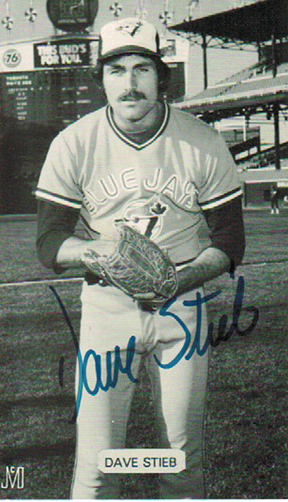
As anyone who knows Blue Jays history is also aware, Stieb had several heart-breaking near-misses en route to finally throwing his no-hitter. The first of those came 30 years ago this week, on August 24, 1985. Facing 300-game winner Tom Seaver of the White Sox in Chicago, Stieb had a no-hitter through eight innings. He’d walked three, and only two runners had gotten as far as second base, but on the first pitch in the bottom of the ninth, Rudy Law took Stieb deep. No-hitter gone. Shutout too. Three pitchers later, Bryan Little hit another home run.
Pitch counts were never reported in those days, so it’s unclear how many pitches Stieb had thrown. He told reporters his arm had begun to tighten up and that manager Bobby Cox might not have sent him out for the ninth if not for the no-hitter. Now, Cox turned to Gary Lavelle … who promptly gave up a home run to Harold Baines. After finally recording the first out, Lavelle surrendered a single to Carlton Fisk. The near-blowout was in danger of getting away, bringing Cox back to the mound.
Since the Blue Jays had started to contend in 1983 the bullpen had aways been a weakness. Now, finally, Toronto had someone to turn to when the game got tight. Only it wasn’t the person we’d all expected when the 1985 season began.
I remember exactly where I was when I heard that the Blue Jays had acquired Bill Caudill from Oakland at the Winter Meetings in December of 1984. (The deal cost Toronto Dave Collins – a player I liked a lot – and Alfredo Griffin – whom everybody liked, but, paraphrasing Sports Illustrated, “who was Alfredo Griffin to keep Tony Fernandez in the minors?” … and, by the way, when the Blue Jays first called up Fernandez in September of 1983, I was sent to the airport to pick him up! He gave me a bat as a souvenir.)
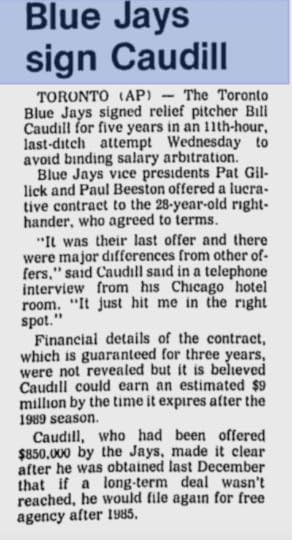
Caudill’s contract was expiring when the Blue Jays acquired him, and I also remember exactly where I was in February of 1985 when I heard they’d avoided going to arbitration with him. I was thrilled. Locking up Caudill was the move that was going to put us over the top, but it went bad right from the start.
Caudill struggled in spring training, and then pitched poorly (despite picking up a pair of wins) when Toronto opened the season in Kansas City. A few days later in Baltimore, the Blue Jays were leading the Orioles 7-3 in the bottom of the eighth when Caudill entered the game with two on and nobody out. (Remember when teams used their relief aces that way?) He promptly issued a walk to load the bases, gave up a run-scoring ground out, a single to make it 7-5 … and then a monster three-run homer to Eddie Murray. Jim Acker got out of the inning, but the Blue Jays lost 8-7.
“I’m no superman,” Caudill would say as his struggles continued … but fortunately, the Blue Jays had Clark Kent waiting in reserve!

I most decidedly do not remember where I was when the Blue Jays claimed Tom Henke from the Texas Rangers in January of 1985 as compensation for losing Cliff Johnson to free agency. But as Caudill struggled, I do remember the reports on Henke in the press notes I would read in the photographers dugout where we on the ground crew watched the games. The late-blooming 27-year-old bricklayer from Taos, Missouri was putting up stunning numbers in Syracuse. By the time he got to Toronto on July 28, Henke’s Triple-A numbers read: 51.1 innings, 13 hits, 18 walks and 60 strikeouts. He had a 2-1 record with 18 saves and had surrendered only five runs (all of them earned) for an ERA of 0.88.
Henke got a nerve-wracking win in a 4-3, 10-inning victory in Baltimore in his Blue Jays debut on July 29, 1985. He picked up a more efficient win two days later. His first save came at home versus Texas on August 2. Bill Caudill earned a sloppy save the following night, but it was the last one he got in 1985. Tom Henke ruled the back of the bullpen now, and it turned the franchise around. Henke got the final two outs to save Stieb’s near no-hitter 30 years ago this week, and kept on racking up saves until the Blue Jays were World Series champions in 1992.



